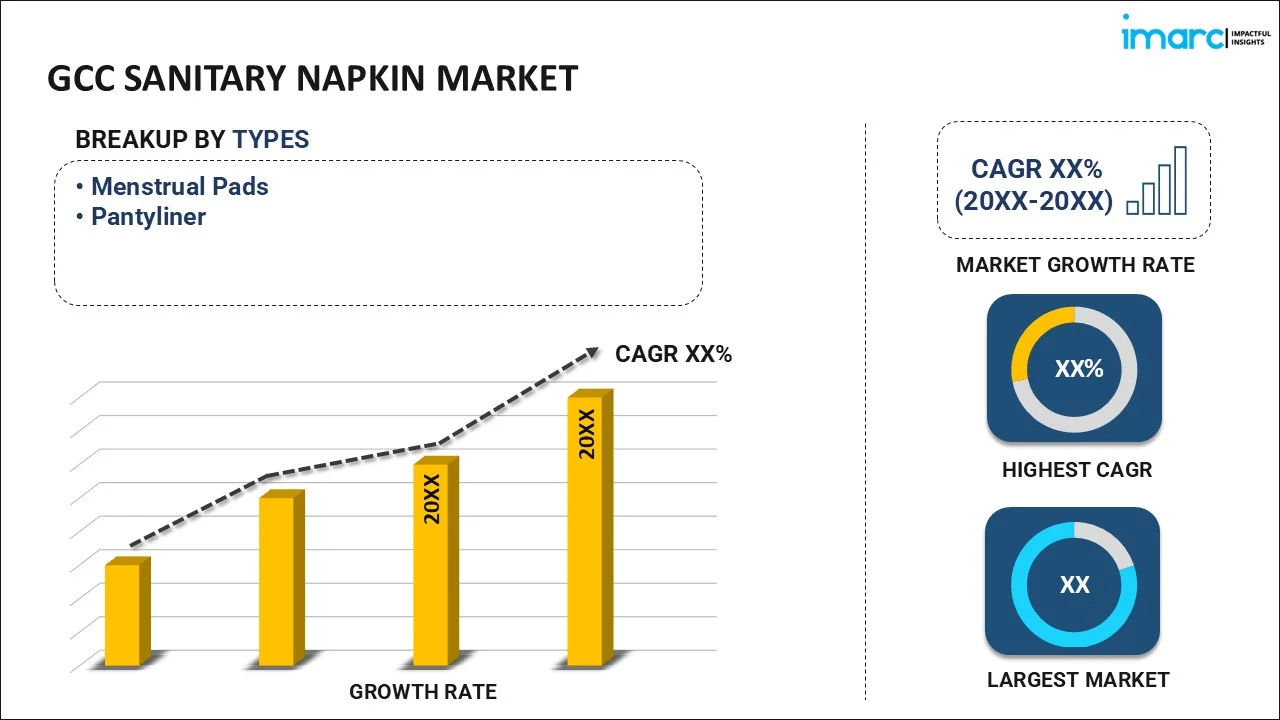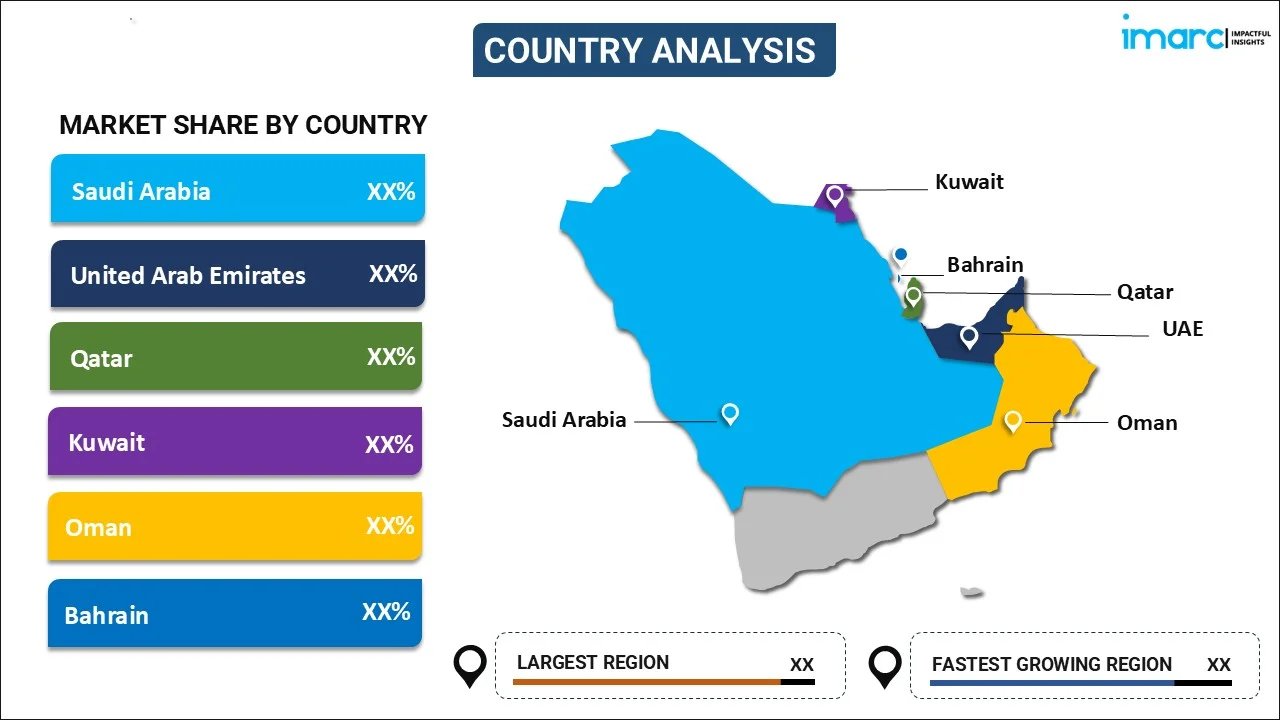
GCC Sanitary Napkin Market Report by Type (Menstrual Pad, Pantyliner), Distribution Channel (Supermarkets and Hypermarkets, Pharmacies, Convenience Stores, Online, Specialty Stores, and Others), and Country 2025-2033
Market Overview:
The GCC sanitary napkin market size reached USD 564.6 Million in 2024. Looking forward, IMARC Group expects the market to reach USD 810.5 Million by 2033, exhibiting a growth rate (CAGR) of 4.1% during 2025-2033. The increasing consumer awareness regarding menstrual hygiene, the expanding female population and workforce, ongoing product innovations, rapid urbanization, and favorable government initiatives are among the key factors driving the market growth.
|
Report Attribute
|
Key Statistics
|
|---|---|
|
Base Year
|
2024
|
|
Forecast Years
|
2025-2033
|
|
Historical Years
|
2019-2024
|
|
Market Size in 2024
|
USD 564.6 Million |
|
Market Forecast in 2033
|
USD 810.5 Million |
| Market Growth Rate 2025-2033 | 4.1% |
A sanitary napkin, commonly known as a menstrual pad, is a disposable absorbent product designed for menstrual hygiene management. It is used by individuals who menstruate to absorb menstrual flow during their monthly periods. Sanitary napkin is usually made of soft, absorbent material and is worn inside undergarments. It is marketed in a variety of sizes and thicknesses to cater to various flow levels. Modern sanitary napkins often feature a moisture-absorbing core and a leak-proof backing to provide comfort and protection. They play a crucial role in maintaining personal hygiene and preventing staining during menstruation, offering convenience and peace of mind to users.
The escalating consumer awareness and emphasis on personal hygiene and women's health are influencing the demand for sanitary napkins in the GCC region. In line with this, increasing education and the proliferation of awareness campaigns are sensitizing women to adopt these products for menstrual hygiene management, which, in turn, is creating a favorable outlook for market expansion. Moreover, the growing female population and the entry of women into the workforce have resulted in a higher demand for convenient and reliable menstrual hygiene products. In addition to this, significant improvements in product innovation and technology have led to the development of more comfortable and effective sanitary napkins, contributing to the market's growth. Furthermore, the shift towards urbanization and changing lifestyle patterns have increased the acceptance and usage of disposable sanitary napkins, aiding in market expansion. Besides this, numerous government initiatives and healthcare awareness programs promoting menstrual hygiene and improving accessibility to these products are propelling the market forward.
GCC Sanitary Napkin Market Trends/Drivers:
Cultural shift and changing norms
The GCC region has been experiencing a significant cultural shift regarding the acceptance and openness toward discussing menstrual hygiene and related products. Traditionally, the topic of menstruation was considered taboo, leading to limited discussions and access to menstrual hygiene products. However, in recent years, there has been a gradual transformation in societal norms and attitudes. This change is primarily due to increasing awareness campaigns, advocacy by women's health organizations, and educational initiatives that aim to destigmatize menstruation. As a result, women are becoming more comfortable discussing menstrual hygiene and seeking better products, such as sanitary napkins, to manage their periods effectively. This cultural shift has led to a substantial rise in the demand for sanitary napkins in the GCC region.
Rising disposable incomes and urbanization
Economic growth and urbanization have significantly impacted the lifestyle and spending patterns of individuals in the GCC countries. The region has witnessed rapid urban development, along with an increase in disposable income among the population, particularly women. As more women join the workforce and become financially independent, their purchasing power for personal care products, including sanitary napkins, has escalated. Urbanization has also led to a fast-paced lifestyle where women are seeking more convenient and practical menstrual hygiene solutions. Sanitary napkins offer a hassle-free and portable option, aligning with the demands of the modern urban woman. The combination of rising disposable income and urbanization has contributed to a surge in the adoption of sanitary napkins in the GCC market.
GCC Sanitary Napkin Industry Segmentation:
IMARC Group provides an analysis of the key trends in each segment of the GCC sanitary napkin market report, along with forecasts at the regional and country levels from 2025-2033. Our report has categorized the market based on type and distribution channel.
Breakup by Type:

- Menstrual Pad
- Pantyliner
Menstrual pad represents the most widely used type
The report has provided a detailed breakup and analysis of the market based on the type. This includes menstrual pad and pantyliner. According to the report, menstrual pad represented the largest segment.
The increasing focus on women's health and hygiene is propelling the demand for menstrual pads in the GCC region. With growing awareness about the importance of menstrual hygiene and its impact on overall well-being, more women are seeking reliable and comfortable menstrual hygiene products such as menstrual pads, contributing to the market's growth. Additionally, the rise of women empowerment movements and the push for gender equality has led to a greater emphasis on providing accessible and effective menstrual care solutions, creating a favorable market outlook. Furthermore, ongoing advancements in product technology have resulted in the development of innovative and superior menstrual pads that offer enhanced absorption, leak protection, and comfort, further fueling the demand. The convenience and ease of use associated with menstrual pads have also contributed to their popularity among women of all age groups. As a result, the demand for menstrual pads continues to rise as women prioritize their health and embrace modern menstrual hygiene solutions.
Breakup by Distribution Channel:
- Supermarkets and Hypermarkets
- Pharmacies
- Convenience Stores
- Online
- Specialty Stores
- Others
Supermarkets and hypermarkets account for the majority of the market share
A detailed breakup and analysis of the market based on the distribution channel has also been provided in the report. This includes supermarkets and hypermarkets, pharmacies, convenience stores, online, specialty stores, and others. According to the report, supermarkets and hypermarkets accounted for the largest market share.
Product distribution through supermarkets and hypermarkets is playing a significant role in impelling the growth of the sanitary napkin market. These large-scale retail outlets offer several advantages, such as their extensive reach and widespread presence in urban and suburban areas, ensuring that sanitary napkins are readily available to a vast consumer base. This enhanced accessibility encourages more women to purchase and use the product regularly, positively impacting the market growth. Moreover, supermarkets and hypermarkets often carry a diverse range of sanitary napkin brands and variants, allowing customers to choose products that suit their preferences and needs. This variety boosts consumer satisfaction and loyalty, driving repeat purchases and aiding in market expansion. Additionally, the visibility of sanitary napkins on prominent shelves and strategic product placements in these stores result in heightened brand visibility and awareness among shoppers, strengthening the market growth.
Breakup by Country:

- Saudi Arabia
- UAE
- Qatar
- Oman
- Kuwait
- Bahrain
Saudi Arabia holds the largest share in the market
The report has also provided a comprehensive analysis of all the major regional markets, which include Saudi Arabia, UAE, Qatar, Oman, Kuwait, and Bahrain. According to the report, Saudi Arabia accounted for the largest market share.
The increasing focus on women's health and hygiene in Saudi Arabia has led to expanding awareness of the importance of menstrual hygiene management, which, in turn, is impelling the market growth. As education and awareness campaigns spread, more women are opting for sanitary napkins as a reliable and convenient solution during menstruation. Moreover, societal changes, including a rising female workforce participation rate and changing lifestyle patterns, have led to an increased demand for modern menstrual hygiene products. With more women engaging in various professional activities, there is a greater need for effective and discreet menstrual care solutions, and sanitary napkins fulfill this requirement. Furthermore, the expanding retail infrastructure in Saudi Arabia, including the presence of supermarkets, pharmacies, and online platforms, has significantly improved the accessibility and availability of sanitary napkins to consumers across the country, aiding in market expansion.
Competitive Landscape:
The competitive landscape of the GCC sanitary napkin market is characterized by intense rivalry among both established and emerging players. The market is witnessing a growing number of manufacturers vying to gain a larger market share, leading to constant innovation and product development. Established multinational companies and regional players dominate the market, leveraging their brand reputation and extensive distribution networks. These companies invest heavily in marketing and advertising to increase brand visibility and consumer loyalty. Additionally, product differentiation through features, such as enhanced absorbency, eco-friendly materials, and skin-friendly attributes, is a common strategy adopted by players to attract consumers. Moreover, mergers and acquisitions are prevalent in the market, allowing companies to expand their product portfolios and geographical presence.
The report has provided a comprehensive analysis of the competitive landscape in the market. Detailed profiles of all major companies have also been provided.
GCC Sanitary Napkin Market Report Scope:
| Report Features | Details |
|---|---|
| Base Year of the Analysis | 2024 |
| Historical Period | 2019-2024 |
| Forecast Period | 2025-2033 |
| Units | Million USD |
| Scope of the Report | Exploration of Historical and Forecast Trends, Industry Catalysts and Challenges, Segment-Wise Historical and Predictive Market Assessment:
|
| Types Covered | Menstrual Pads, Pantyliner |
| Distribution Channels Covered | Supermarkets and Hypermarkets, Pharmacies, Convenience Stores, Online, Specialty Stores, Others |
| Countries Covered | Saudi Arabia, UAE, Qatar, Oman, Kuwait, Bahrain |
| Customization Scope | 10% Free Customization |
| Post-Sale Analyst Support | 10-12 Weeks |
| Delivery Format | PDF and Excel through Email (We can also provide the editable version of the report in PPT/Word format on special request) |
Key Questions Answered in This Report:
- How has the GCC sanitary napkin market performed so far, and how will it perform in the coming years?
- What are the drivers, restraints, and opportunities in the GCC sanitary napkin market?
- What is the impact of each driver, restraint, and opportunity on the GCC sanitary napkin market?
- What is the breakup of the market based on the type?
- Which is the most attractive type in the GCC sanitary napkin market?
- What is the breakup of the market based on the distribution channel?
- Which is the most attractive distribution channel in the GCC sanitary napkin market?
- What is the competitive structure of the GCC sanitary napkin market?
- Who are the key players/companies in the GCC sanitary napkin market?
Key Benefits for Stakeholders:
- IMARC’s report offers a comprehensive quantitative analysis of various market segments, historical and current market trends, market forecasts, and dynamics of the GCC sanitary napkin market from 2019-2033.
- The research study provides the latest information on the market drivers, challenges, and opportunities in the GCC sanitary napkin market.
- Porter's five forces analysis assist stakeholders in assessing the impact of new entrants, competitive rivalry, supplier power, buyer power, and the threat of substitution. It helps stakeholders to analyze the level of competition within the GCC sanitary napkin industry and its attractiveness.
- Competitive landscape allows stakeholders to understand their competitive environment and provides an insight into the current positions of key players in the market.
Need more help?
- Speak to our experienced analysts for insights on the current market scenarios.
- Include additional segments and countries to customize the report as per your requirement.
- Gain an unparalleled competitive advantage in your domain by understanding how to utilize the report and positively impacting your operations and revenue.
- For further assistance, please connect with our analysts.
 Request Customization
Request Customization
 Speak to an Analyst
Speak to an Analyst
 Request Brochure
Request Brochure
 Inquire Before Buying
Inquire Before Buying




.webp)




.webp)












